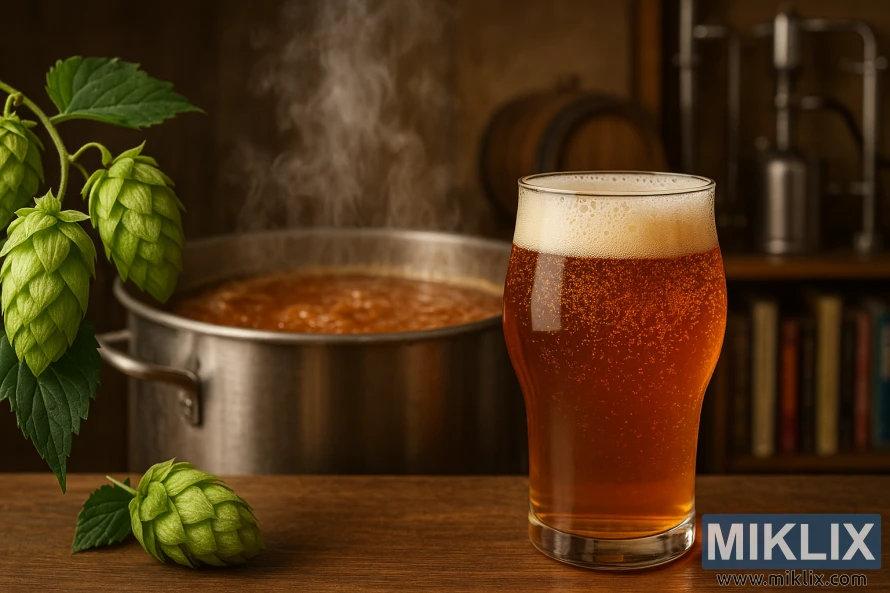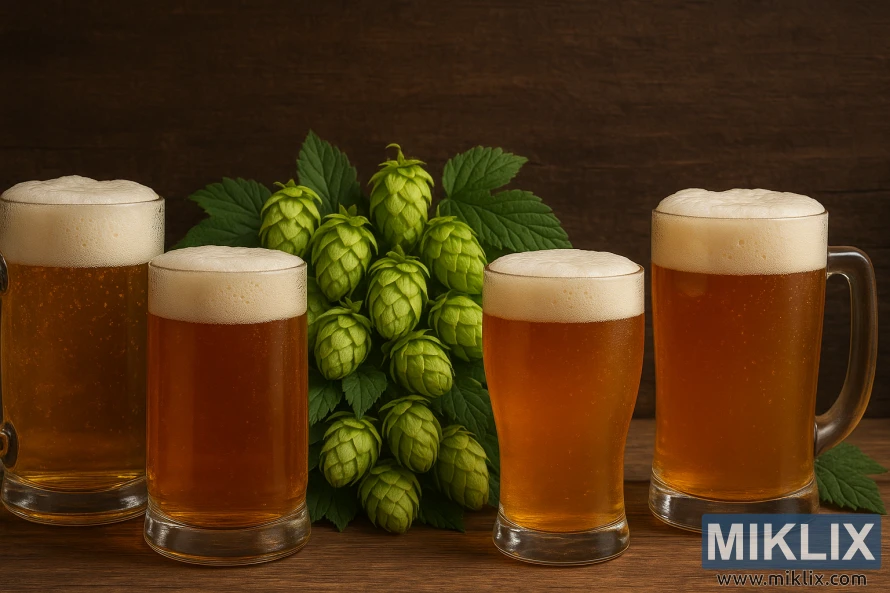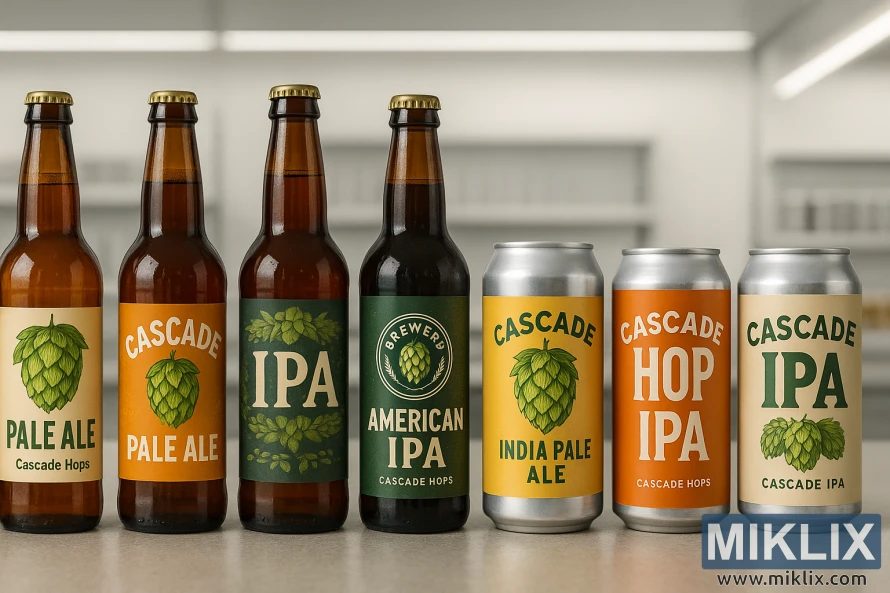Hops in Beer Brewing: Cascade
Published: August 10, 2025 at 4:39:24 PM UTC
Beer brewing is an art that requires a deep understanding of various ingredients, including hop varieties. Cascade hops have become popular for their unique characteristics. They contribute significantly to beer's flavor and aroma. Cascade hops are celebrated for their floral, spice, and citrus notes, with a distinct grapefruit flavor. This makes them a favorite among brewers, who often use them in American beer styles like pale ales and IPAs.

Key Takeaways
- Cascade hops are a popular variety used in many American beer styles.
- They are known for their floral, spice, and citrus flavors.
- Cascade hops are perfectly suited for pale ales and IPAs.
- Their unique grapefruit character adds depth to beer.
- Understanding hop varieties is essential for beer brewing.
The History of Cascade Hops
The journey of Cascade hops started in the 1950s with the USDA hop breeding program. This marked the start of a new chapter in hop development. It aimed to meet the changing tastes of American beer lovers.
In 1972, Cascade hops were introduced to the public. This was a critical time for American craft brewing, on the brink of a major shift. Ever after, they've been a key component in many American beer styles, celebrated for their distinct flavor and aroma.
The creation of Cascade hops was a major achievement in American beer brewing's history. Here are some key points that underscore their significance:
- Cascade hops were among the first hop varieties bred for the American market.
- They were developed to offer a unique flavor and aroma, setting them apart from traditional European hops.
- The release of Cascade hops in 1972 aligned with the dawn of the American craft brewing movement. They quickly became a cornerstone in many pioneering breweries.
The influence of Cascade hops on American beer brewing is immense. They've played a vital role in defining the taste of iconic American beer styles, like pale ales and IPAs.
Understanding Cascade Hops Characteristics
Cascade hops stand out for their unique traits, making them a top pick among brewers. They are known for their floral, spicy, and citrus notes, with a prominent grapefruit flavor. This distinct taste makes them a go-to for many American beer styles, such as pale ales, IPAs, and barley wines.
Their distinct flavor and aroma come from their high oil content. This includes myrcene, humulene, and caryophyllene. These compounds are key to their aroma and flavor, making them versatile in beer brewing. Cascade hops are characterized by:
- Floral notes that add a subtle, perfumy quality to beers
- Spicy and herbal undertones that enhance the beer's complexity
- Citrus flavors, with a strong grapefruit note, that add brightness and refreshment
These characteristics make Cascade hops perfect for brewers aiming for balanced and complex flavors. They are ideal for pale ales, IPAs, and other styles. Cascade hops bring a unique set of qualities that elevate the brewing process and the final product.
Chemical Composition and Properties
Understanding Cascade hops' chemical makeup is key to appreciating their brewing role. They are celebrated for their balanced chemical properties, making them a top choice among brewers.
Cascade hops boast a moderate alpha acid range, from 5.0 to 8.0%. Alpha acids are vital for adding bitterness to beer. This bitterness is essential in balancing the beer's sweetness, coming from malt.
They also contain a notable amount of beta acids, usually between 5.0 to 7.5%. Beta acids influence beer's flavor and aroma, but their impact can vary with brewing techniques.
The mix of alpha and beta acids in Cascade hops makes them suitable for many beer styles. Their moderate alpha acid content ensures balanced bitterness. At the same time, their beta acid content enriches the beer's flavor and aroma.
- The alpha acid content in Cascade hops provides bitterness.
- Beta acids in Cascade hops contribute to the flavor and aroma.
- The balance of alpha and beta acids makes Cascade hops versatile.
To fully utilize Cascade hops in brewing, one must grasp their chemical composition. Recognizing the importance of alpha and beta acids allows brewers to craft beers with just the right balance of bitterness and complex flavors.
Aroma and Flavor Profile
Cascade hops bring a rich tapestry of floral, spice, and citrus notes to beer. This combination creates a complex aroma and flavor profile.
The sensory description of Cascade hops is diverse. It includes floral, spicy, and citrus qualities. A distinct grapefruit character is a key feature, making it a favorite among brewers.
The unique flavor profile of Cascade hops can be broken down into several key components:
- Floral notes that add a subtle, perfumistic quality
- Spicy undertones that enhance the beer's complexity
- Citrus flavors, with a focus on grapefruit, that contribute to the beer's brightness and refreshment
Cascade hops are versatile and can be used in various beer styles. They are perfect for pale ales, IPAs, and barley wines. Their aroma and flavor profile make them an ideal choice for brewers aiming to create complex, flavorful beers.
Growing and Harvesting Cascade Hops
The journey of growing and harvesting Cascade hops is both complex and detailed. It necessitates a meticulous focus on every aspect, from soil and climate selection to the adoption of optimal farming and cultivation methods.
Cascade hops thrive in various global regions, including the United States, Europe, and Australia. Cultivating these hops requires a profound grasp of their specific needs. This includes proper irrigation and disease management.
Effective hop farming and cultivation involve the use of disease-resistant varieties and regular pruning. It's also vital to monitor the plants for any signs of disease or pests. Here are some essential considerations for growing Cascade hops:
- Selecting soil that is well-draining and rich in nutrients
- Implementing a suitable irrigation system to support the plants' water needs
- Pruning the plants regularly to promote healthy growth
- Monitoring for signs of disease or pests and taking action as needed
Harvesting Cascade hops is a critical phase. It usually happens in late summer or early fall, when the cones are ripe and fragrant. The timing of the harvest greatly affects the quality and flavor of the hops.
To achieve the highest quality, Cascade hops must be harvested at the perfect moment. This involves frequent checks on the cones for ripeness and the use of specialized equipment to assess alpha acid content and other critical characteristics.
Best Beer Styles for Cascade Hops
Cascade hops are celebrated for their citrus and floral notes, making them a favorite among brewers. They are ideal for certain beer styles that highlight these unique qualities.
Some of the best beer styles for Cascade hops include:
- Pale Ales: Cascade hops are a classic choice for American pale ales, where their citrus notes complement the malt profile.
- IPAs: The bold, hoppy flavor of IPAs is a perfect match for Cascade hops, which add depth and complexity to the beer.
- Barley Wines: Cascade hops can also be used in barley wines, where their floral and citrus notes enhance the beer's overall character.
Cascade hops are versatile and can be used in various other beer styles. But they truly shine in pale ales and IPAs. Their unique flavor and aroma profile make them an ideal choice for brewers looking to create beers with a distinct American character.
In summary, Cascade hops are a versatile variety that can be used in a range of beer styles. They are, though, best suited for pale ales, IPAs, and other hop-forward beers. This allows their unique characteristics to be showcased.

Brewing Techniques with Cascade Hops
Brewing with Cascade hops demands a thorough grasp of various techniques to fully harness their essence. These hops are celebrated for their floral and citrusy notes, making them a staple in craft brewing. The techniques employed can greatly influence the beer's final taste and aroma.
Dry hopping and hop backing are two prominent methods used with Cascade hops. Dry hopping involves adding hops post-fermentation, allowing their unique flavors and aromas to meld into the beer without adding bitterness. This technique is ideal for beers where a strong hop aroma is sought.
Hop backing, in contrast, involves adding hops during brewing, usually towards the end of the boil. It contributes to both the beer's bitterness and flavor. Adjusting the timing of hop additions can fine-tune the balance between bitterness, flavor, and aroma.
Beyond dry hopping and hop backing, brewers can explore other techniques to enhance Cascade hops' use. These include:
- Hop bursting: Adding a significant amount of hops towards the end of the boil to maximize flavor and aroma.
- First wort hopping: Adding hops to the wort before boiling, which can boost the beer's flavor and aroma.
- Hop blending: Combining Cascade hops with other varieties to craft complex flavor profiles.
The choice of brewing technique with Cascade hops hinges on the desired beer characteristics. By mastering these techniques, brewers can craft a diverse array of beer styles that highlight Cascade hops' unique attributes.
Proper Storage and Handling
To keep Cascade hops in top condition, it's vital to adhere to the best storage and handling practices. These hops are quite sensitive to their environment. If not stored correctly, they can lose their distinctive flavors and aromas.
Here are some best practices for storing Cascade hops:
- Store hops in a cool, dry place, away from direct sunlight and moisture.
- Keep hops in airtight containers or bags to prevent exposure to air and moisture.
- Maintain a consistent refrigerated temperature between 32°F and 40°F (0°C and 4°C) to slow down the degradation process.
When handling Cascade hops, it's important to be gentle to avoid damage. This care helps preserve their quality. Key handling practices include:
- Handle hops gently to avoid bruising or breaking the cones, which can lead to a loss of essential oils.
- Use clean equipment and utensils when handling hops to prevent contamination.
- Minimize exposure to air and light during handling to prevent degradation.
By sticking to these storage and handling best practices, brewers can keep their Cascade hops fresh and flavorful. This ensures their beer's quality remains high.
Cascade Hops Substitutes
While Cascade is a popular hop variety, substitutes can be used in its place. Brewers may need alternatives due to supply chain issues, regional availability, or to experiment with new flavors.
Several hop varieties can serve as substitutes for Cascade hops, providing similar flavor and aroma profiles. Centennial hops, for example, share a similar citrus and floral character with Cascade. Chinook hops, known for their pine and spicy notes, can also be used as a substitute in certain beer styles.
Columbus hops are another alternative, with a robust flavor profile that includes earthy and citrus notes. When substituting Cascade hops, brewers should consider the specific characteristics of the alternative variety. They should think about how these will impact the overall flavor and aroma of the beer.
Using alternative hop varieties can help brewers create unique and interesting flavor profiles. Experimenting with different hop substitutes can lead to the development of new beer styles and recipes.
- Centennial: Similar citrus and floral notes
- Chinook: Pine and spicy characteristics
- Columbus: Robust, earthy, and citrus flavors
By understanding the characteristics of these alternative hop varieties, brewers can make informed decisions. They can decide when to use them as substitutes for Cascade hops. This enhances their brewing creativity and flexibility.
Common Brewing Mistakes to Avoid
To maximize the benefits of Cascade hops, brewers must steer clear of common pitfalls. One major mistake is choosing the wrong hops or using them incorrectly. This can drastically alter the beer's taste and aroma.
Understanding Cascade hops' characteristics is essential. They interact with other brew ingredients in complex ways. Incorrect hop amounts can result in an unbalanced flavor. Brewers must accurately measure and track hop usage to prevent this.
Another frequent error is neglecting the alpha acid and cohumulone levels in Cascade hops. These elements influence the beer's bitterness and flavor stability. Knowing these properties helps brewers make better decisions about when and how to use Cascade hops.
To sidestep these mistakes, brewers should:
- Choose fresh, high-quality Cascade hops for the best flavor and aroma.
- Properly store hops to maintain their potency and characteristics.
- Keep an eye on brewing conditions like temperature and pH to enhance hop utilization.
By recognizing and avoiding these common errors, brewers can fully exploit Cascade hops' unique qualities. This leads to the creation of exceptional beers.
Recipe Development Guidelines
Creating a beer recipe with Cascade hops demands a thorough grasp of their traits and how they blend with other components. Cascade hops are celebrated for their floral, citrus, and slightly sweet taste. This makes them a favorite for crafting a wide array of beer styles.
Several key steps are vital when brewing with Cascade hops. First, choosing the right hop variety is critical. It's important to know its alpha acid content and essential oils. Cascade hops boast a moderate alpha acid range, from 4.5% to 6%. This versatility allows them to enhance both bitterness and flavor/aroma.
To fully harness Cascade hops, brewers should adhere to a few principles:
- Balance the hop blend to achieve the desired flavor and aroma.
- Choose a malt and yeast that complement Cascade hops' characteristics.
- Keep a close eye on the brewing process to preserve the hops' unique qualities.
By adhering to these guidelines and grasping Cascade hops' properties, brewers can craft beers that are both complex and balanced. These beers will highlight the unique aspects of this versatile hop variety.
Commercial Examples Using Cascade Hops
Cascade hops have played a significant role in the creation of beloved beers in the industry. Their versatility and unique flavor profile have made them a key ingredient in many iconic brews. This has showcased their ability to enhance a wide range of beer styles.
Sierra Nevada Pale Ale stands out as a prime example, becoming synonymous with Cascade hops. Its balanced bitterness and floral aroma are largely due to the hops. Another notable example is Anchor Liberty Ale, celebrated for its complex flavor and aromatic qualities.
These examples highlight Cascade hops' impact on the brewing world. By using them, breweries have crafted beers with distinct flavors that resonate with diverse palates. This has solidified Cascade hops as a staple in many breweries' hop collections.
- Sierra Nevada Pale Ale
- Anchor Liberty Ale
- Other notable beers that utilize Cascade hops
The success of these beers has cemented Cascade hops' place in the brewing industry. They are now a fundamental part of many breweries' hop inventories, reflecting their widespread appeal and versatility.

Pairing Cascade Hops with Other Varieties
Brewers often blend Cascade hops with other varieties to craft innovative beers. This approach leads to unique flavor and aroma profiles. It allows for the creation of complex, balanced beers that highlight each hop's strengths.
Cascade hops are celebrated for their floral and citrus notes. They pair well with hops like Chinook or Centennial, adding depth to the beer's flavor. The success of hop pairing depends on understanding how each hop's characteristics interact.
- Willamette: Adds a spicy and earthy note
- Amarillo: Contributes a citrusy and fruity flavor
- Mosaic: Introduces complex flavors of tropical fruit and pine
When blending hops, brewers must consider alpha acid content, flavor profile, and aroma. This careful selection and blending process enables brewers to craft beers with unique, captivating flavors.
Experimenting with hop pairings allows brewers to create a wide range of beer styles. From IPAs with bold citrus flavors to pale ales with subtle floral notes, the art of hop pairing is a powerful tool. It enables brewers to craft beers that are both complex and balanced.
Troubleshooting Hop-Related Issues
Brewers often face challenges when working with Cascade hops. These can be overcome with the right techniques. It's critical to troubleshoot hop-related issues to achieve the desired flavor and aroma in beer.
One frequent problem is over-hopping or under-hopping, which greatly affects the beer's taste. To prevent this, brewers must accurately measure hops. They should adjust quantities based on the recipe and brewing method.
Other common issues include oxidation, which can cause unpleasant flavors, and poor hop storage. This can lead to a loss of aroma and flavor. To address these, hops should be stored in a cool, dry place. They should be used within a reasonable timeframe.
Here are some common hop-related issues and their solutions:
- Over-hopping: Reduce the amount of hops used or adjust the hopping schedule.
- Under-hopping: Increase the amount of hops used or adjust the hopping schedule.
- Oxidation: Store hops in airtight containers and minimize exposure to air.
- Poor hop storage: Store hops in a cool, dry place and use them within a reasonable timeframe.
By understanding these common issues and implementing the right solutions, brewers can effectively troubleshoot hop-related problems. This way, they can produce high-quality beers with Cascade hops.
Advanced Brewing Techniques
Experimental brewing with Cascade hops has opened new avenues for brewers to explore unique flavor profiles. By incorporating advanced brewing techniques, brewers can now create a wide range of beers that showcase the versatility of Cascade hops.
One of the key aspects of advanced brewing with Cascade hops is the ability to manipulate the brewing process to accentuate the hop's characteristics. This can involve techniques such as late hopping, dry hopping, or even using Cascade hops in the brewing water.
Some brewers are experimenting with Cascade hops in various beer styles, from IPAs to pale ales, and even in sour beers. The use of Cascade hops in these styles can add complexity and depth to the beer.
- Using Cascade hops for late hopping to preserve the delicate aroma.
- Incorporating Cascade hops into dry hopping regimens for enhanced flavor.
- Experimenting with Cascade hops in different beer styles to create unique profiles.
By mastering advanced brewing techniques with Cascade hops, brewers can innovate and differentiate their beers in a competitive market. The key is to understand the characteristics of Cascade hops and how to best utilize them in the brewing process.

Conclusion
Cascade hops have become a cornerstone in American beer brewing, most prominently in pale ales and IPAs. Their distinct flavor and aroma, marked by floral and citrus notes, have won brewers' hearts. This makes them a go-to choice for many.
Their versatility shines through in their use across various stages of brewing, from bittering to dry-hopping. By grasping the unique traits of Cascade hops, brewers can explore new horizons in their craft. This opens up a world of possibilities in beer recipes.
In essence, Cascade hops bring a unique flavor and aroma to many beer styles, enriching the brewing process. As the craft of brewing continues to grow, Cascade hops are set to remain a favorite among brewers. Their appeal is likely to endure, shaping the future of beer brewing.
Further Reading
If you enjoyed this post, you may also like these suggestions:
